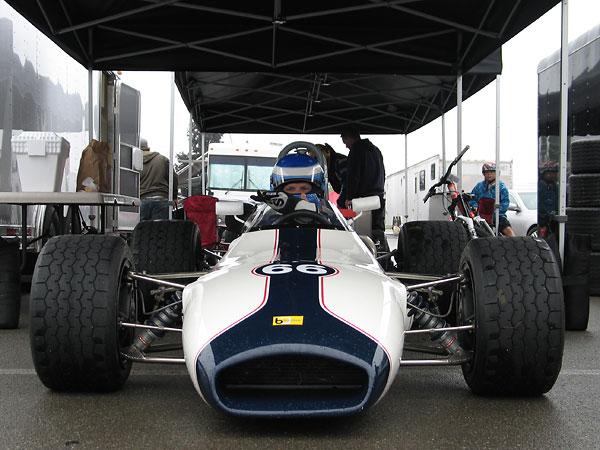
Brad Baker's Brabham BT30 Formula 2 Racecar
Owner: Brad BakerCity: Oshawa, Ontario
Model: 1969 Brabham BT30 (#7 of about 26)
Engine: Cosworth FVA 1.6L
Motor Racing Developments' Brabham BT30 Model
Brabham racecars were the products of a company called Motor Racing Developments.
The company had been a partnership between famous driver Jack Brabham and engineer Ron Tauranac.
Brabham's charisma and connections had long been crucial to the growth and success of the company.
Behind the scenes, Tauranac designed brilliant racecars and managed their impecable construction.
At the end of 1969, Ron Tauranac bought out Jack Brabram's share of Motor Racing Developments.
The two gentlemen didn't part ways; they just divided responsibilities.
Jack Brabham continued running his Formula One racing team.
Ron Tauranac continued constructing top flight racecars.
At the time MRD's main products were the BT28 for Formula Three, the BT29 for Formula B, and the BT30 for Formula Two.
Of all the cars that appeared in Formula Two championship races throughout 1969 and
1970, the Brabham BT30 was the most stalwart if not the most successful.
Brabham BT30s were driven by many excellent drivers but always on behalf of private teams.
In other words, there was no Brabham "works" Formula Two team to compete with the factory-backed
March, Tecno, BMW, Lola, and Ferrari efforts.
Nonetheless the BT30 sold well, filled grids, and reliably took podium finishs.
The BT30 was reliably competitive.
It also proved exceptionally easy to set up for new drivers and to tune for varying track requirements.
Through this era, Formula One drivers would slip into Formula Two racecars occasionally as their schedules allowed.
Jack Brabham, Jackie Stewart, and Jo Bonnier all drove Brabham BT30s on occasion for the John Coombs Racing team!
The most successful BT30 driver was Derek Bell. Driving for Tom Wheatcroft Racing,
Bell finished a strong second place in the 1970 Formula Two championship.
Tim Schenken drove a BT30 for the Sports Motor International team with pretty good success.
Future McLaren star John Watson ran his own independent effort.
Carlos Reutemann (then with Automovil Club Argentina) and Howden Ganley (then with
Motor Racing Enterprises) also drove Brabham BT30s on occasion.
Period Racing Results for Chassis Number BT30-7
| Date | Race Name | Venue | Car# | Results | Comments | |
Giancarlo Gagliardi of Italy, driving for Scuderia Jolly Club | ||||||
| 6/21/1970 | Gran Premio della Lotteria | Monza, Italy | 5 | 6th of 10 | ||
| 6/26/1970 | Trophee de France | Paul Ricard, France | 27 | 12th of 36 | ||
| 8/23/1970 | Gran Premio del Mediterraneo | Enna-Pergusa, Italy | 38 | 14th of 20 | ||
| 8/30/1970 | Festspeilpreis Saltzburg | Salzburgring, Austria | 20 | 8th of 17 | ||
Silvio Moser of Switzerland, driving for Scuderia Jolly Club | ||||||
| 2/7/1971 | Colombia Grand Prix | Bogotá, Columbia | 7 | 8th of 18 | ||
| 2/14/1971 | Bogotá Grand Prix | Bogotá, Columbia | 7 | DNF of 18 | ||
Gian Luigi Picchi of Italy, driving for Scuderia Ala d'Oro | ||||||
| 4/4/1971 | Jim-Clark-Gedächtnis-Rennen | Hockenheim, Germany | 45 | DNF of 30 | ||
Vittorio Brambilla of Italy, driving for Scuderia Ala d'Oro | ||||||
| 4/12/1971 | Jochen Rindt Memorial Trophy | Thruxton, England | 11 | DNF of 30 | (head gasket) | |
| 5/2/1971 | ADAC Eifelrennen | Nürburgring, Germany | 6 | DNF of 37 | (crankshaft) | |
Carlo "Gimax" Franchi of Italy | ||||||
| 6/20/1971 | Non-championship F2 Race | Monza, Italy | 14 | DNQ | ||
Members of the 10-tenths chassis history archive have pieced together BT30's recent ownership trail as follows:
from 1997 Fabio Montani of Italy, from 1998 David Irwin of Colorado (who imported and restored it),
from 1999 Barry Marquardt of Kansas, from 2005 Peter McLaughlin of New Hampshire,
from 2006 James King of Illinois, from 2007 Richard Scott of Ohio, and since 2009 Brad Baker of Ontario.
We extracted the race results above by carefully studying race reports on the marvelous "OldRacingCars.com" website.
Historically, there has been some confusion between Brabham BT30-4 and Brabham BT30-7.
(Please let us know if you can help connect the dots between Scuderia Ala d'Oro and Fabio Montani.)
Features and Specifications
| Engine: | Cosworth FVA 1.6L.
Lucas mechanical fuel injection.
Pipercross foam air cleaner.
Lucas distributor with Pertronix Ignitor breakerless ignition module.
Lucas AB14 electronic ignition amplifier.
Lucas Sport ignition coil.
Moroso Blue Max 8mm spiral core spark plug wires.
RCi plastic breather tank.
NAPA oil filter. |
| Cooling: | custom aluminum crossflow radiator with integral oil cooler. |
| Exhaust: | custom fabricated four into one header. |
| Transaxle: | Hewland FT-200 five speed.
Metalastic drive donuts. |
| Front Susp.: | unequal length wishbones.
Koni double adjustable aluminum coilover shock absorbers with Hyperco springs.
Brabham proprietary magnesium uprights (marked C 1801 2).
Adjustable anti-sway bar.
Brabham proprietary steering rack. |
| Rear Susp.: | inverted lower wishbones, single top links, and twin radius arms.
Koni double adjustable aluminum coilover shock absorbers with Hyperco springs.
Brabham proprietary magnesium uprights (marked MRD 1228).
Adjustable anti-sway bar. |
| Brakes: | (master) dual Girling master cylinders with adjustable bias bar and remote reservoirs. (3/4" front.) (front) Girling AR Mk3 aluminum calipers and solid rotors, (rear) Girling D14R (or D12R?) aluminum calipers and solid rotors. |
| Wheels/Tires: | Brabham magnesium racing wheels (13x10 front and 13x12 rear.)
Avon treaded racing tires (9.0/21.0/13 front and 12.0/23.0/13 rear). |
| Electrical: | Hawker (EnerSys) PowerSafe SBS sealed lead acid battery.
Tilton Super Starter.
Toggle switches, left to right, Rain Light, Ignition, Low Pressure Fuel Pump, and High Pressure Fuel Pump. |
| Instruments: | (left to right)
Smiths dual fuel pressure (0-160psi) and coolant temperature (30-120C) gauge,
Stack tachometer (0-12000 rpm),
Racetech dual engine oil pressure (0-100psi) and oil temperature (40-140C) gauge. |
| Fuel System: | Facet cube-type low pressure electric fuel pump.
High pressure electric fuel pump.
Lucas mechanical fuel pump.
AP canister fuel filter.
Adjustable fuel pressure regulator. |
| Safety Eqpmt: | Willans six-point cam-lock safety harness.
Quick release steering wheel hub.
FireBottle centralized fire suppression system.
SPA Design mirrors. |
Engine Installation
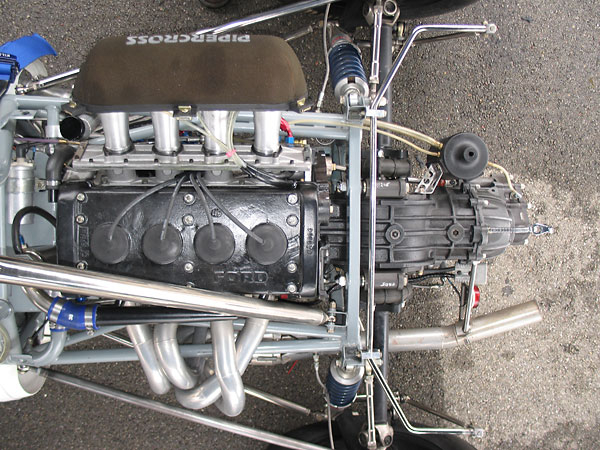
Ford Cosworth FVA (four valve type "A") 1.6 liter engine.
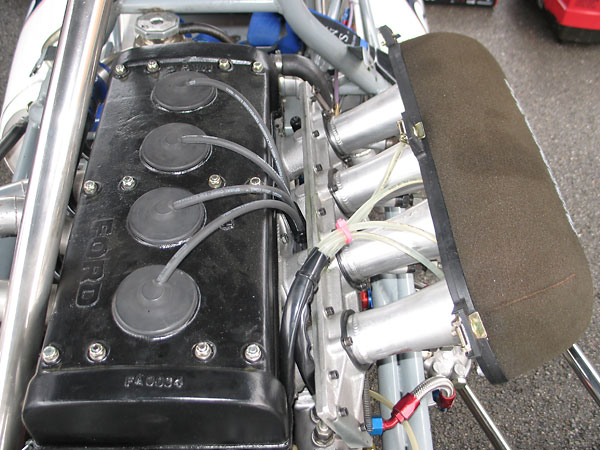
Lucas mechanical fuel injection. The injectors are located just upstream of the throttle slides.
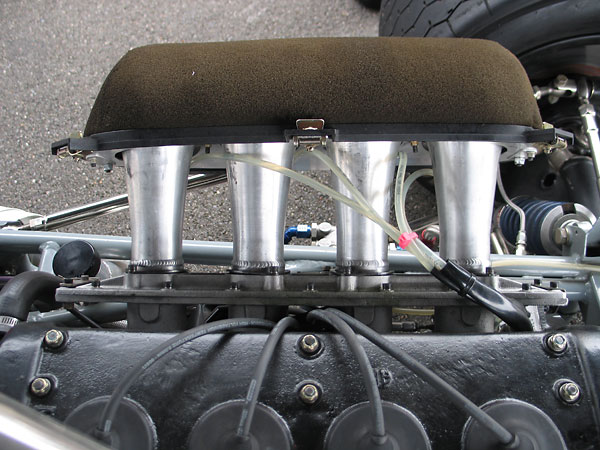
Moroso Blue Max 8mm spiral core spark plug wires.
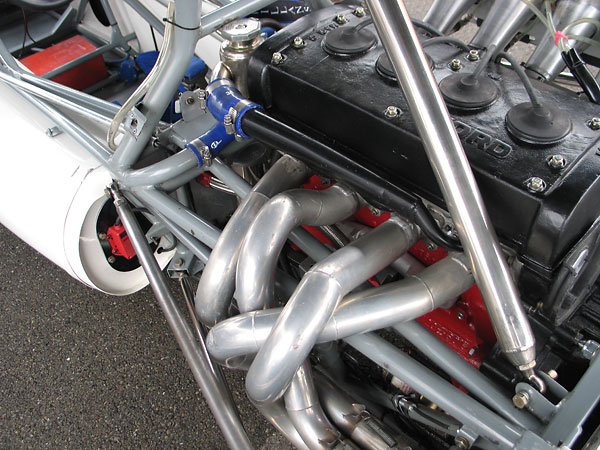
Custom fabricated four into one header.
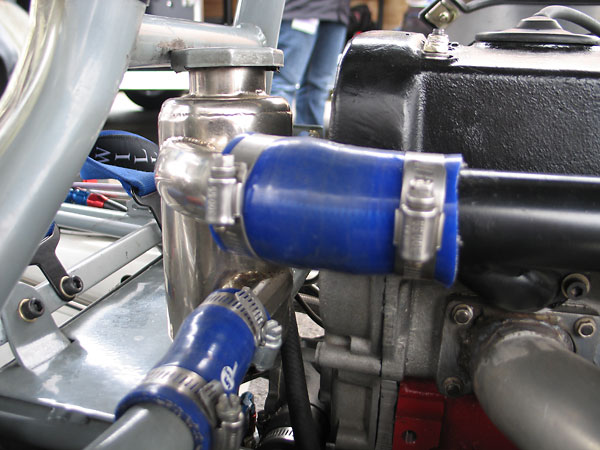
Coolant swirl pot.
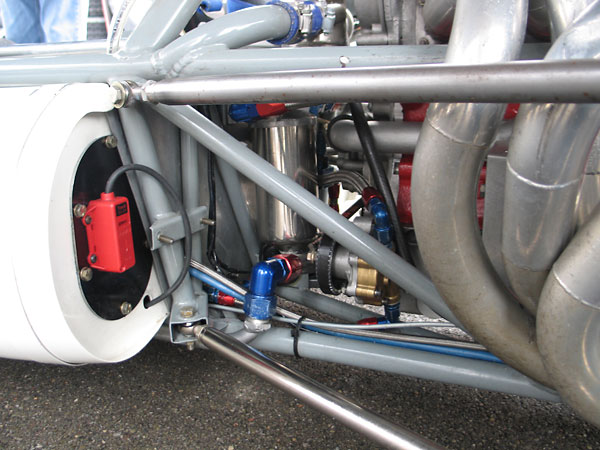
We look forward to photographing a Brabham BT28 Formula Three racecar. Supposedly the BT30
spaceframe is more "complicated." This is one of the views we'll be interested to compare.
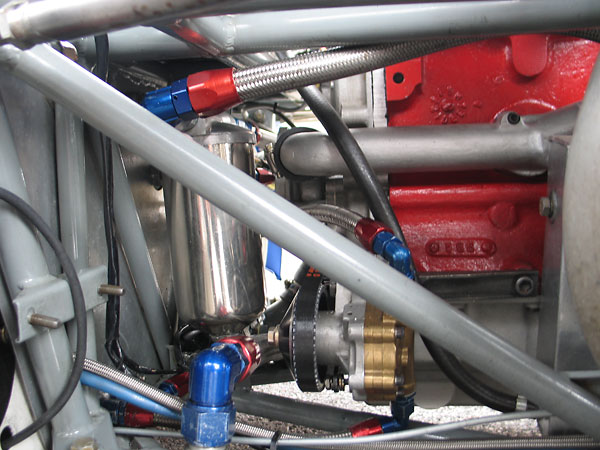
(Left) AP canister fuel filter. (Right) Lucas mechanical fuel pump.
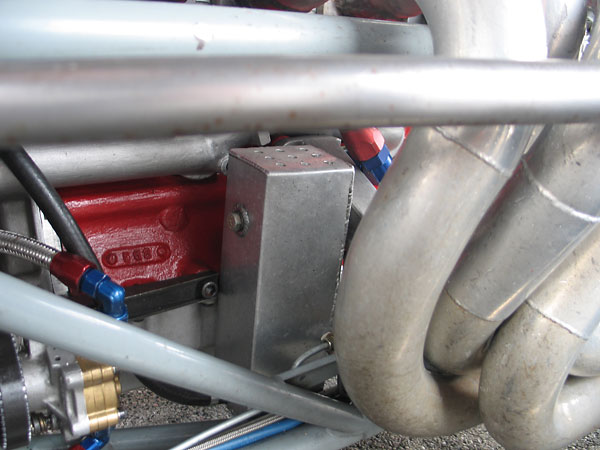
Crankcase breather tank.
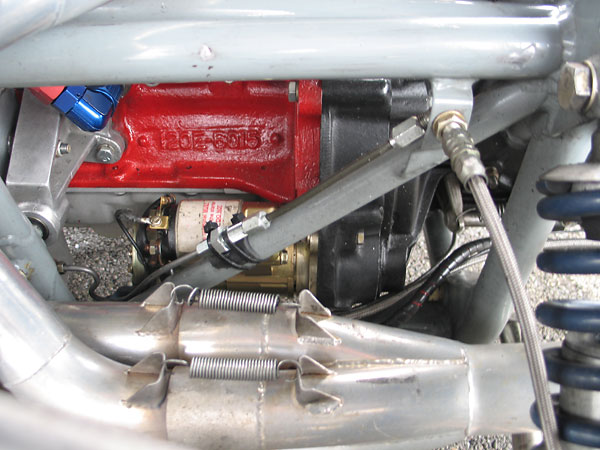
Tilton Super Starter. Behind it, casting number 120E-6015 indicates a Cortina 1.5L engine block.
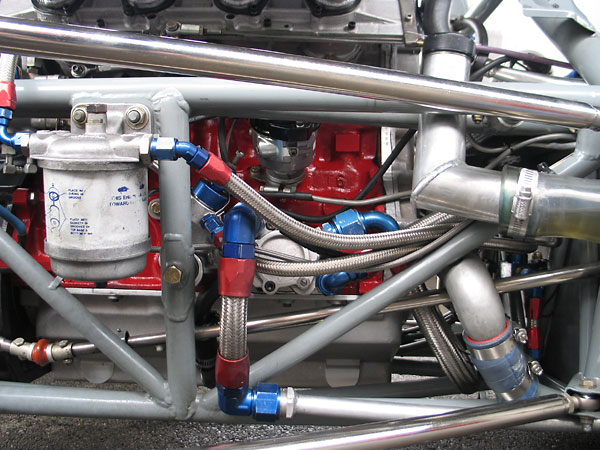
If you spot two leads (in this case, one red and one black) going into a Lucas distributor, it's a safe
bet a modern ignition module has been installed inside in lieu of old-fashioned breaker points. There are
several brands, typically using either optical or Hall effect sensors to achieve more precise spark timing.
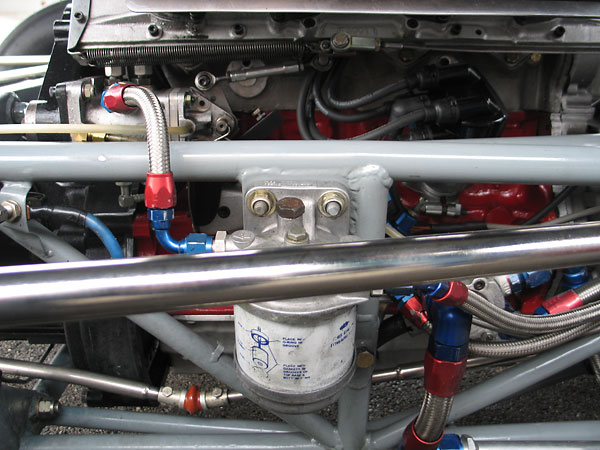
Engine oil filter moount.
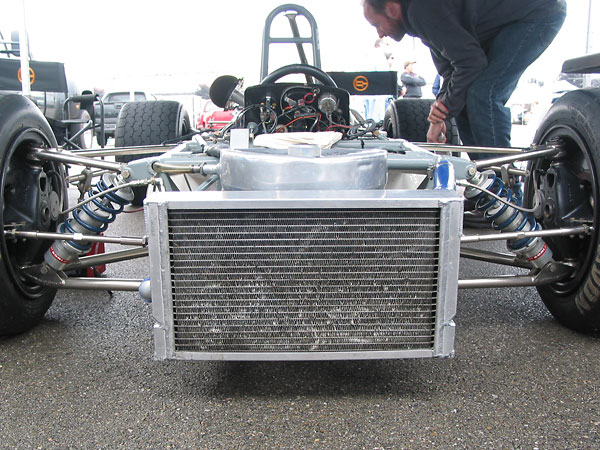
Custom aluminum crossflow radiator with integral oil cooler.
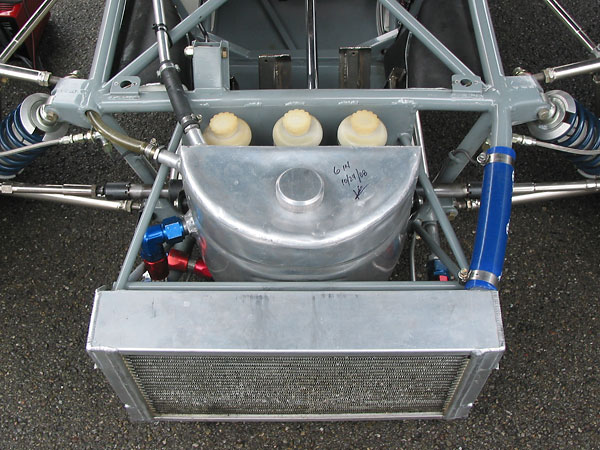
Nose-mounted aluminum engine oil reservoir tank.
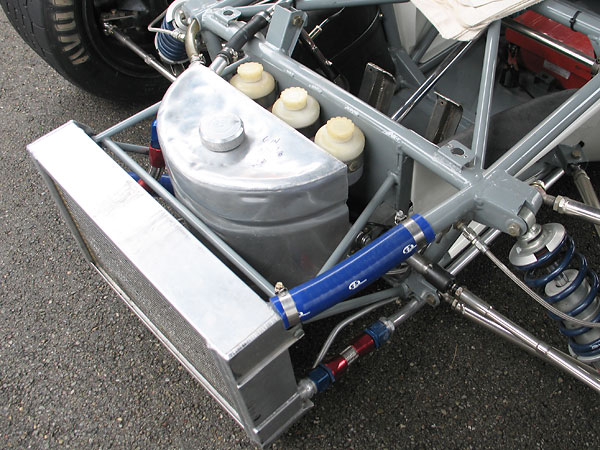
After the radiator, air flows around the oil tank and outboard. By making the front bulkhead
extra narrow, designer Ron Tauranac reduced restriction and thus maximized airflow.
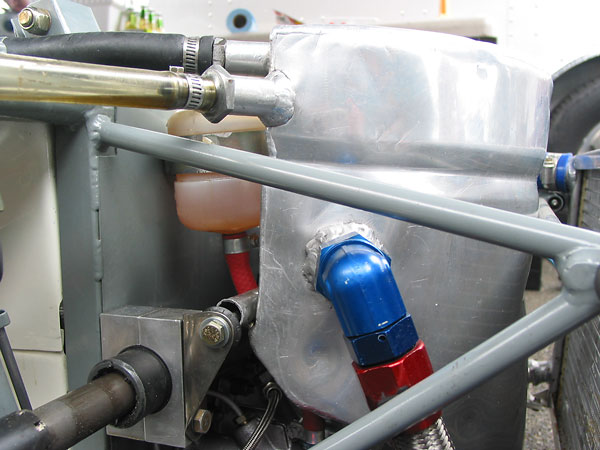
Notice that this Brabham BT30's frame has a steel front bulkhead.
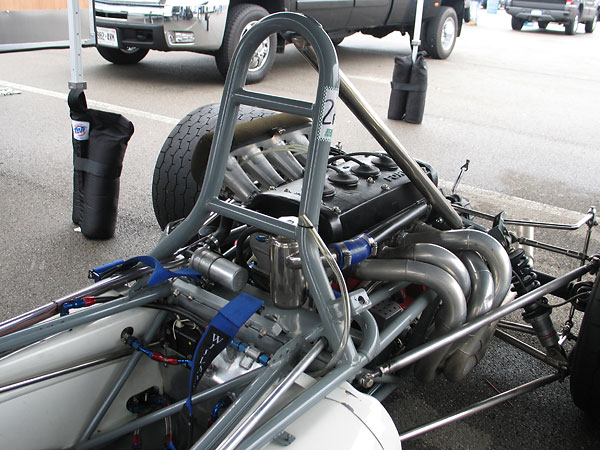
Brabham BT30 roll hoop. The height and rearward brace appear original, but the top-most
horizontal crossmember is probably more modern. Hoop shape is usually one of the easiest
ways to tell a Brabham BT30 from a Brabham BT36. The later model had a wider roll hoop.
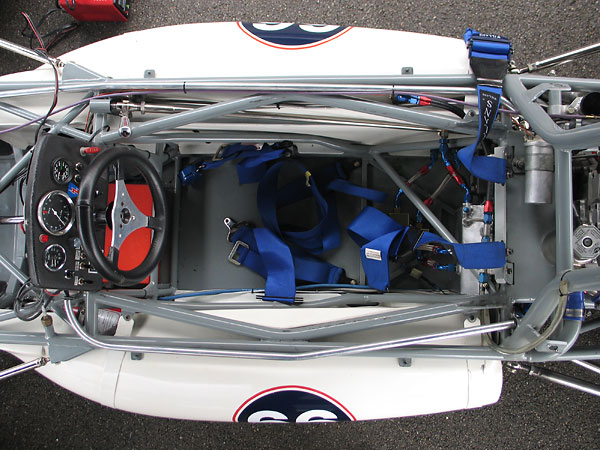
Full length steel floorpans add significantly to the car's strength.
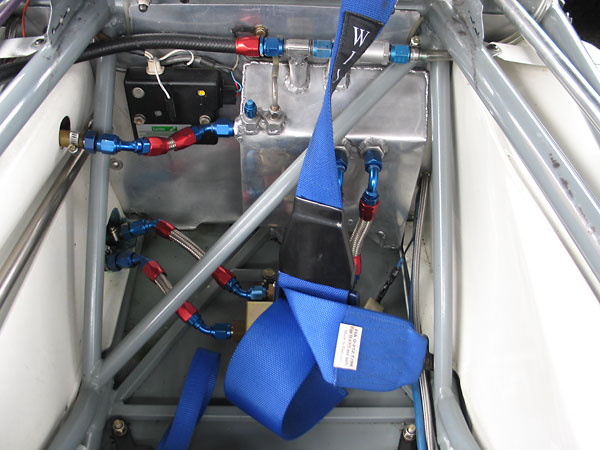
(Left) Lucas AB14 electronic ignition amplifier. (Under belt) Facet cube-type low pressure fuel pump.
Front Suspension / Steering / Etc.
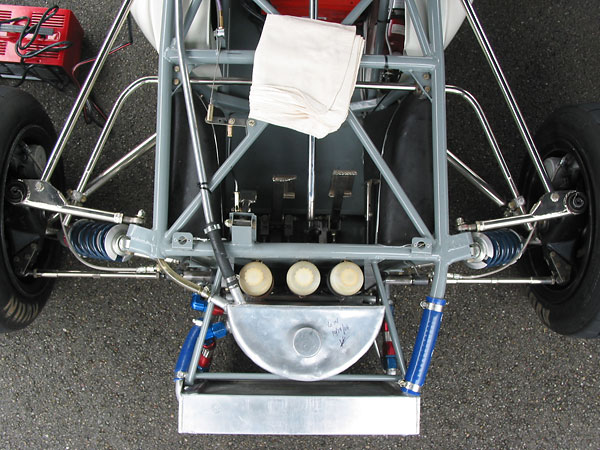
Overview of the Brabham front suspension.
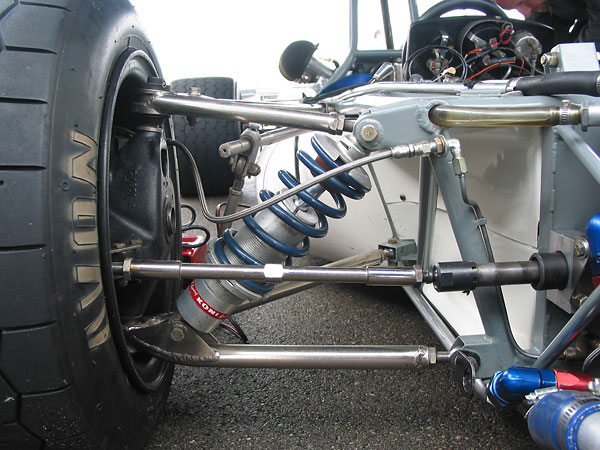
Koni double adjustable aluminum coilover shock absorbers with Hyperco springs.
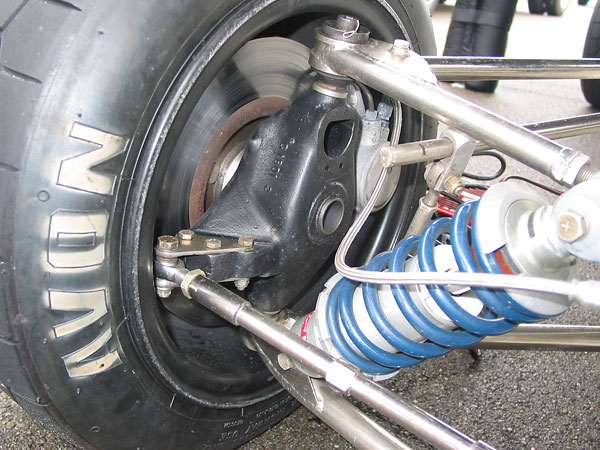
Brabham proprietary magnesium uprights (marked C 1801 2).
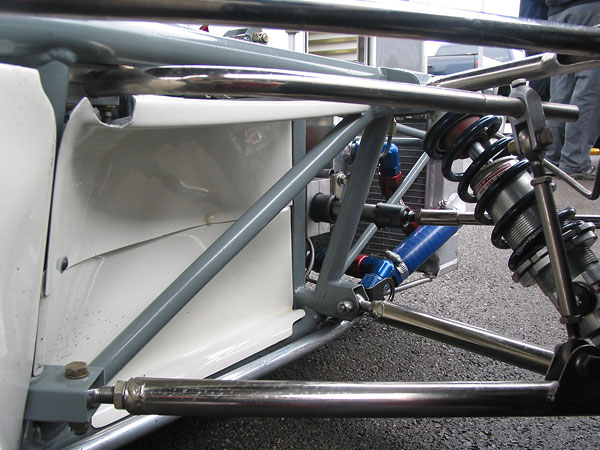
Stout, wide-based wishbones meet well-supported frame nodes.
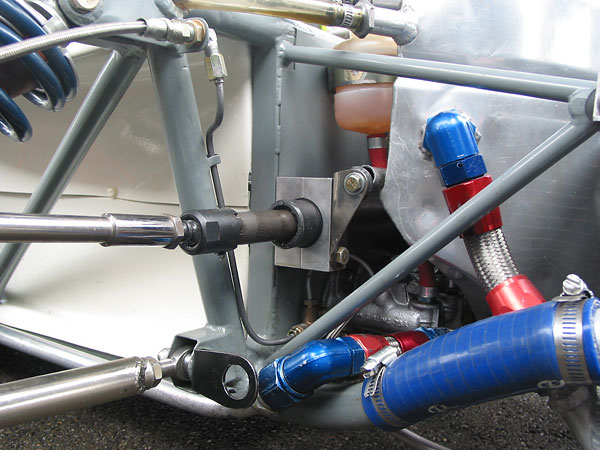
Girling master cylinders, with remote reservoirs. (The front brake master has a 0.75" bore size.)
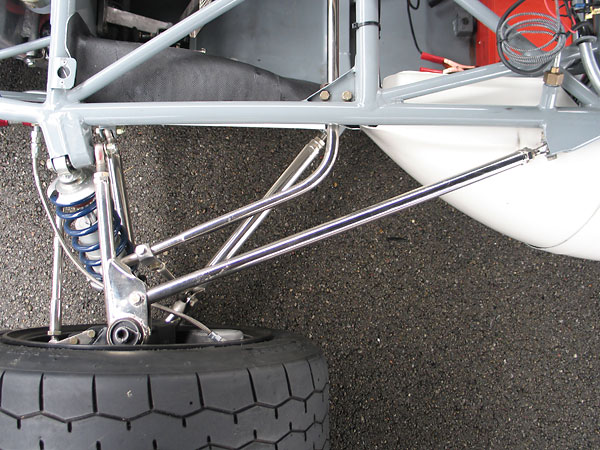
One of the many advantages of spreading out A-arm pick-up points is that any
play in the Heim joints will have less effect on suspension behavior.
Enjoying this article? www.BritishRaceCar.com is partially funded through generous support from readers like you!
To contribute to our operating budget, please click here and follow the instructions.
(Suggested contribution is twenty bucks per year. Feel free to give more!)
Rear Suspension / Transaxle / Etc.
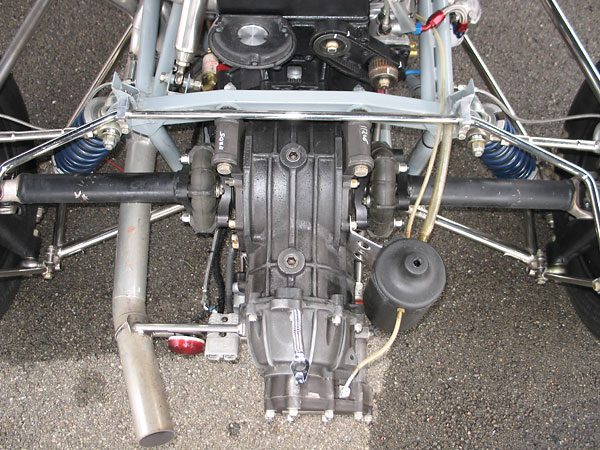
Transaxle mounting features. Higher in the picture, you can see that the fuel injection drive belt and
gears have been marked so one can verify at a glance that the belt hasn't jumped between gear teeth.
Also, the engine's original lightweight camshaft-driven alternator has been removed. (Not recommended.)
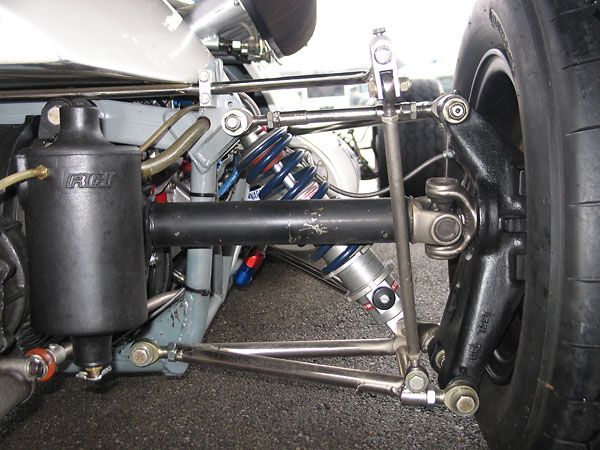
Koni double adjustable aluminum coilover shock absorbers with Hyperco springs.
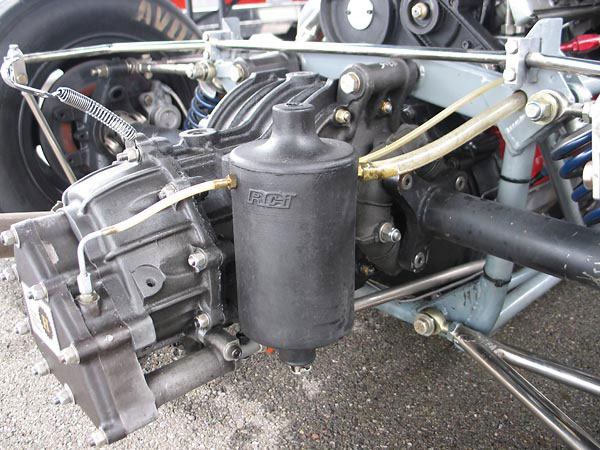
Racer's Choice Inc. ("RCi") one quart black polyethylene overflow catch can.
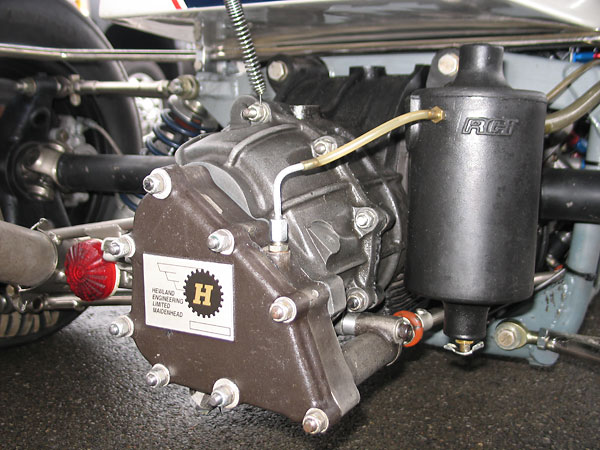
Hewland FT-200 five speed transaxle.
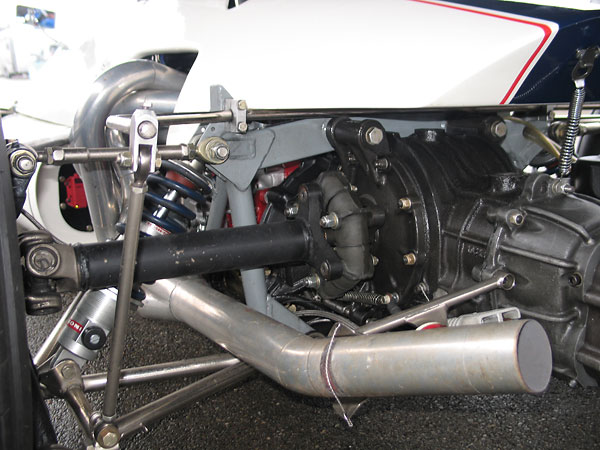
Metalastic drive donuts do something universal joints can't: they absorb inward and outward motion.
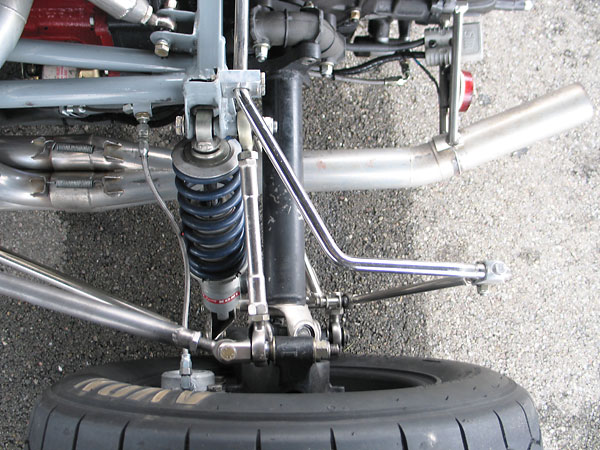
To accomodate rain showers and a damp track, Brad adjusted his rear anti-sway bar to the
softest possible setting. (Note: the Brabham BT30 model came with outboard mounted
rear brakes whereas its successor the BT36 came with inboard mounted rear brakes.)
Body Panels
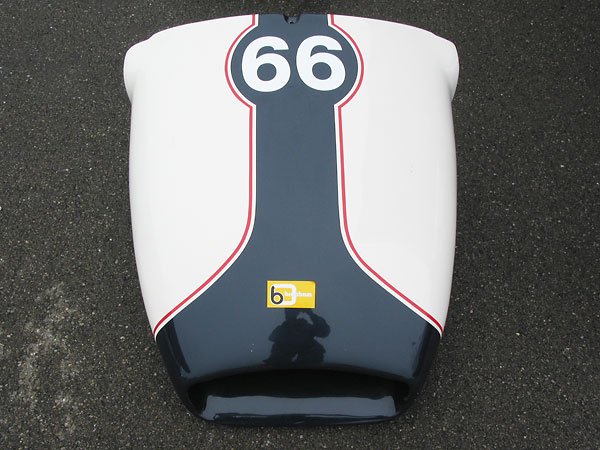
Brabham nose decal.
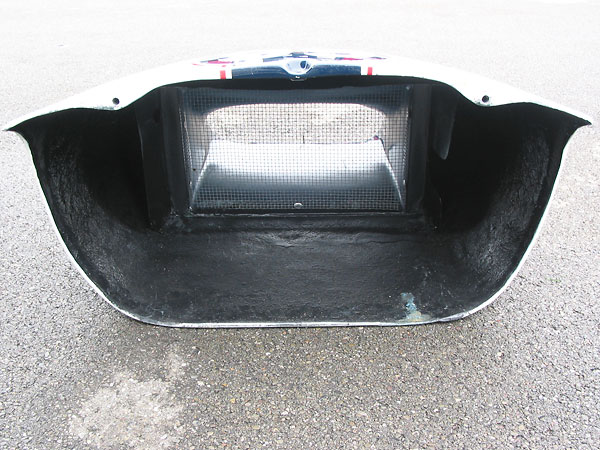
Radiator protecting screen.
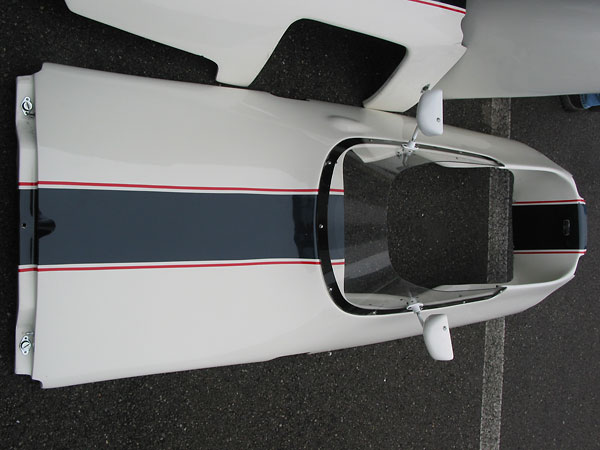
Two Dzus quarter-turn fasteners hold down the front of the cowl panel on a Brabham BT30.
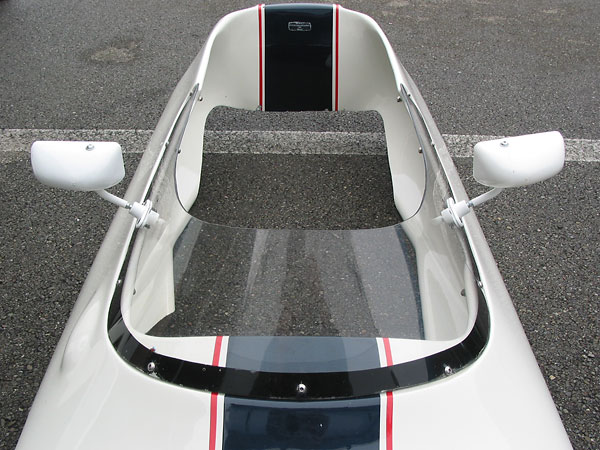
The decal reads: "Bodywork by Specialised Moulding Ltd., England"
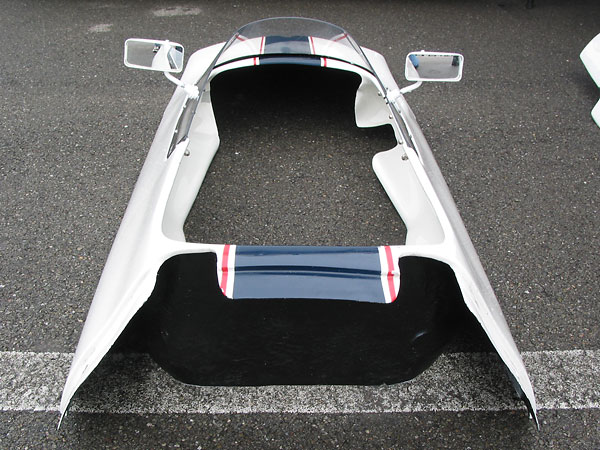
Transparent Brabham BT30 windscreen.
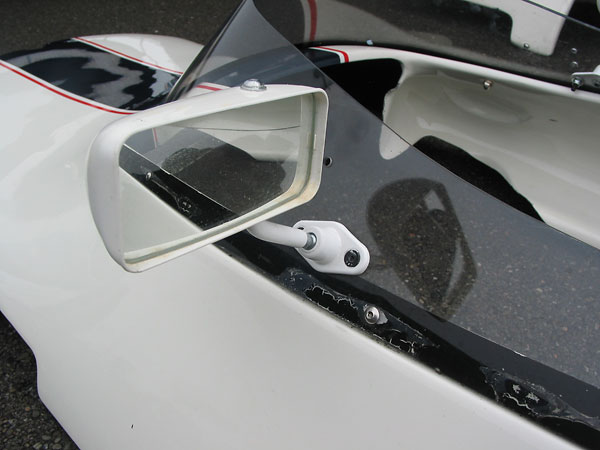
SPA Design mirror.
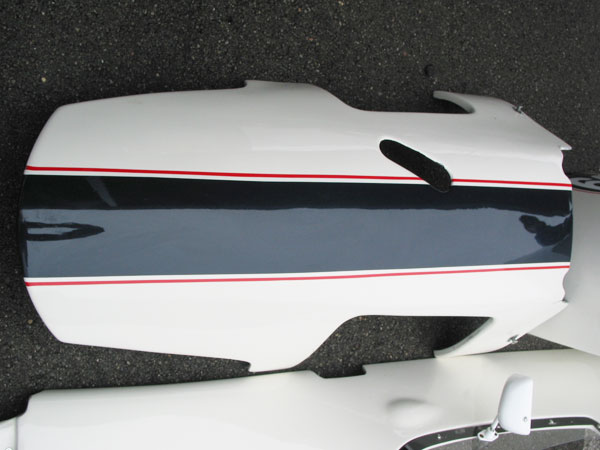
Brabham BT29 and BT30 models used the same engine cover design.
Interior
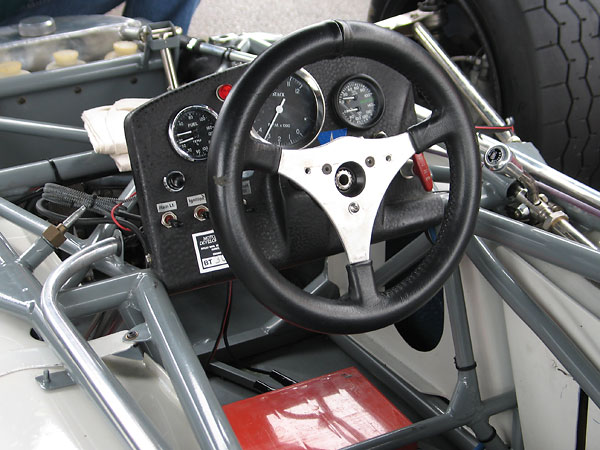
Hawker (EnerSys) PowerSafe SBS sealed lead acid battery mounted on the floor, forward of the seat.
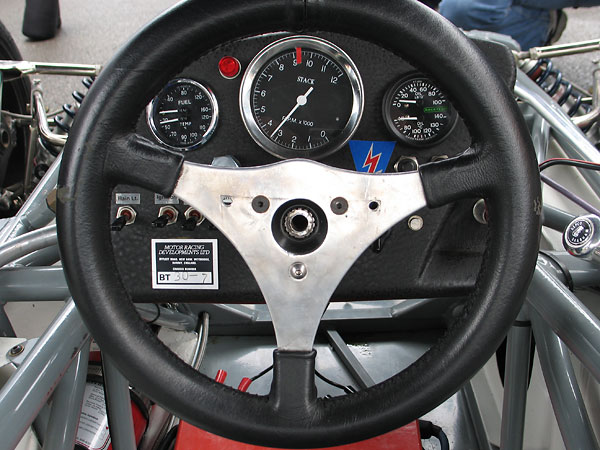
Smiths dual fuel pressure (0-160psi) and coolant temperature (30-120C) gauge, Stack tachometer
(0-12000 rpm), Racetech dual engine oil pressure (0-100psi) and oil temperature (40-140C) gauge.
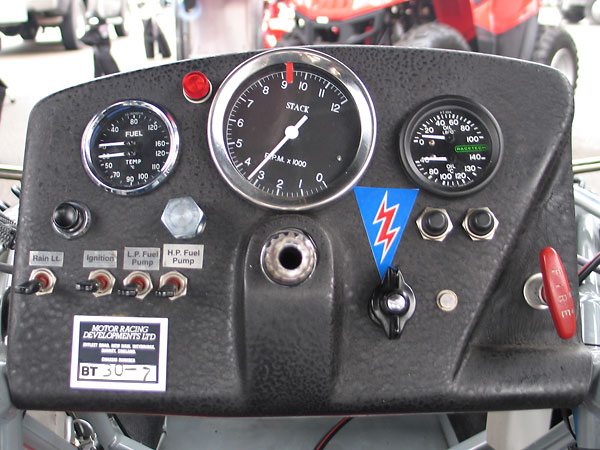
Toggle switches (left to right): rain light, ignition, low pressure fuel pump, and high pressure fuel pump.
Lefthand pushbutton works the starter motor. Righthand pushbuttons operate electronic tach features.
The large black rotary switch is a Lucas battery disconnect switch. (Since this car doesn't have an
alterator, disconnecting the battery will in effect turn off the engine's ignition system.)
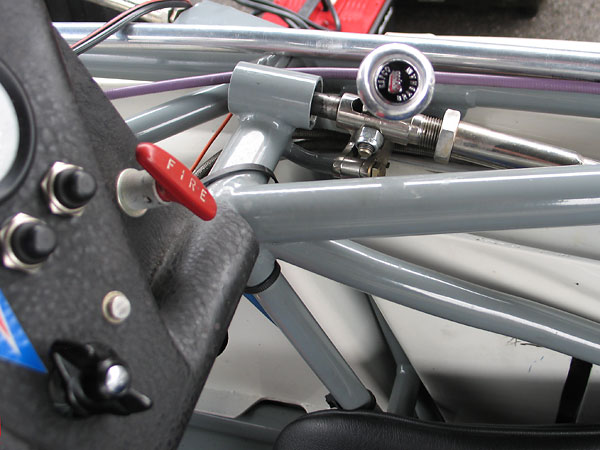
At left: the red "fire" knob can be pulled to operate the onboard fire suppression system.
At right: the Repco-Brabham emblem on the shifter knob is leftover from earlier in the sixties.
The Australian Repco firm had multiple connections to Motor Racing Developments. Famously,
Repco had provided engines for Brabham's 1966 through 1968 season Formula One cars.
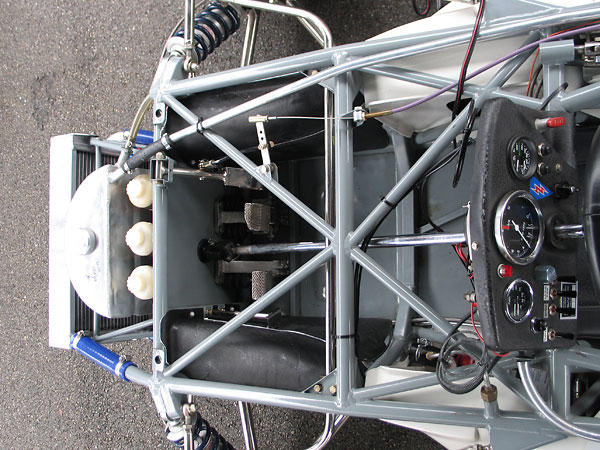
Brabham BT30 frame construction details.
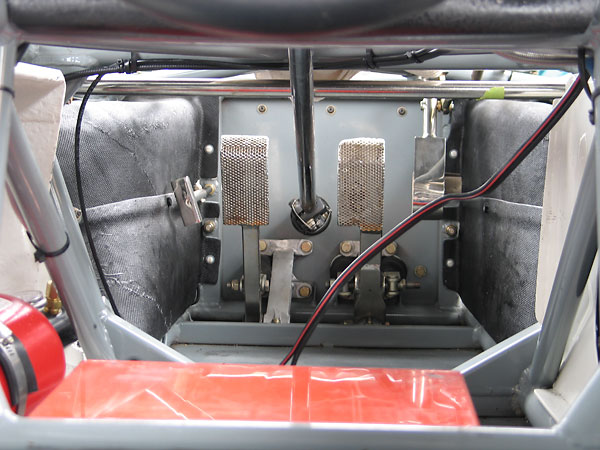
Clutch, brake and throttle pedals on a Brabham BT30.
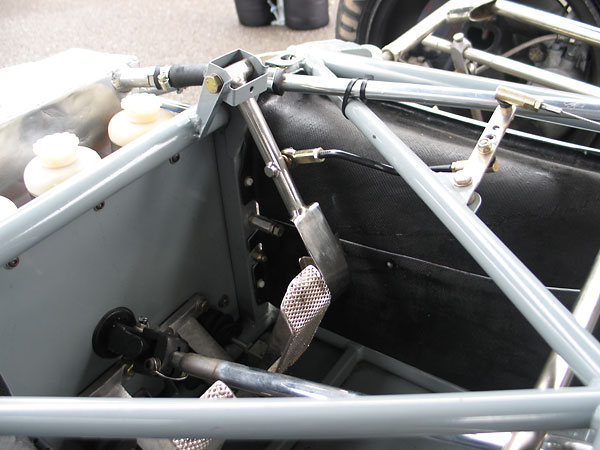
Usually, throttle pedals have a stop bolt at both ends of their travel.
In this photo you can see that that the rearward stop bolt isn't installed.
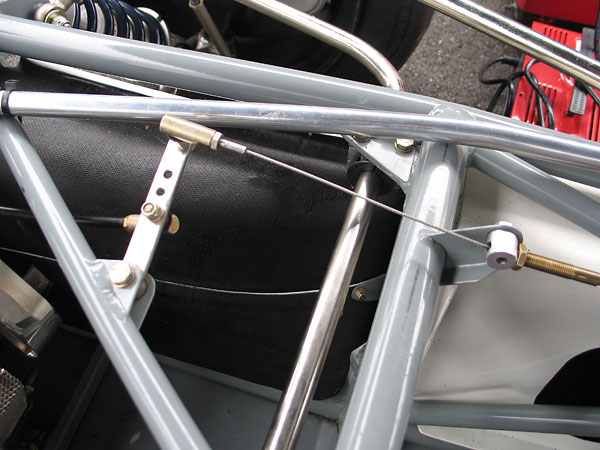
Throttle linkage on Brabham BT30.
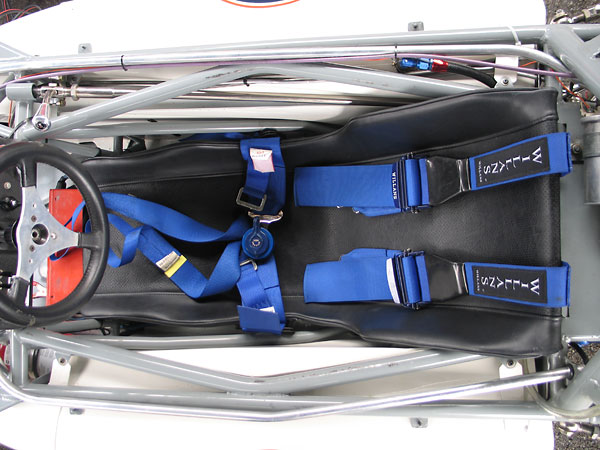
Willans six-point cam-lock safety harness.
Exterior
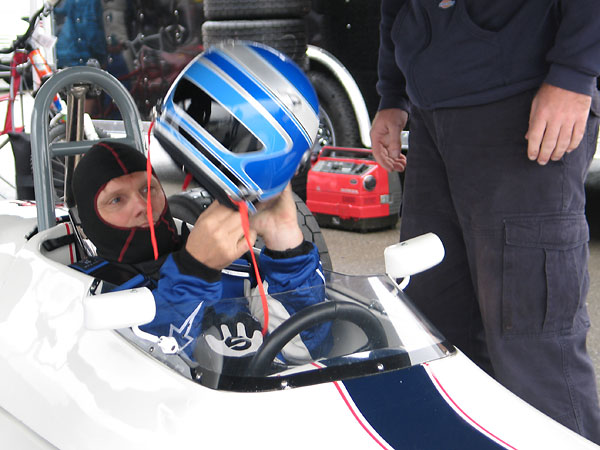
Driving the Brabham, Brad Baker finished third in class and sixth overall in the Group 2 feature
race of the 2009 U.S. Vintage Grand Prix at Watkins Glen, with a best lap time of 2:02.163.
That's an average speed of 100.2mph over the 3.4 mile circuit.
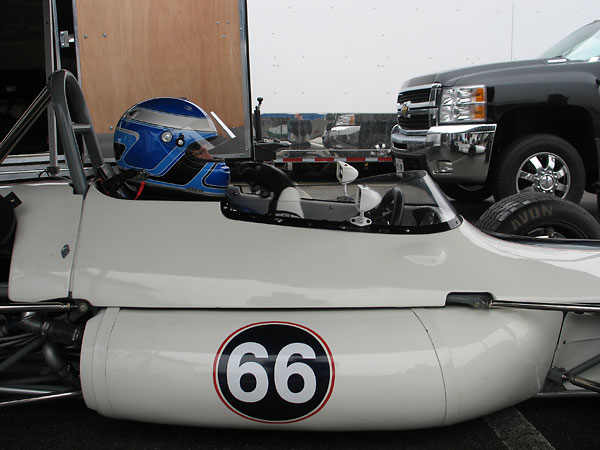
The first eight BT30s were built with aluminum sidepods. After that, BT30s came with fiberglass sidepods.
In either case, fuel cells with rubber safety bladders (as mandated by Formula Two rules) were mounted
inside the sidepods. The fiberglass sidepod design was carried over to Brabham's BT36 model.
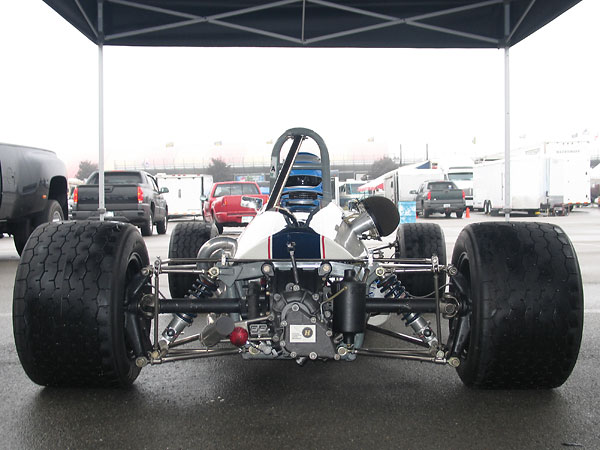
Treaded racing tires are mandated by the "Monoposto Rules" that Brad races under.
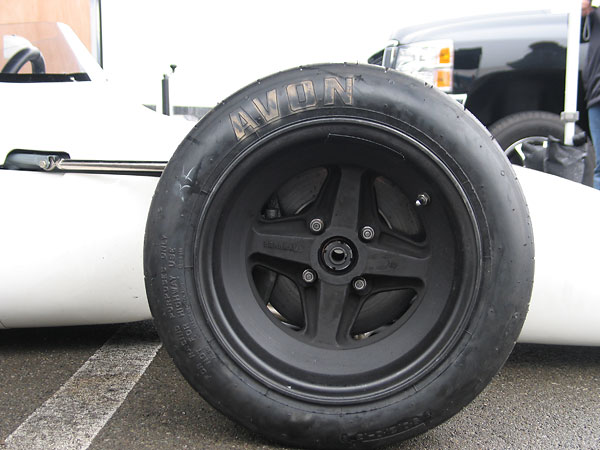
Brabham magnesium racing wheels (13x10 front and 13x12 rear.)
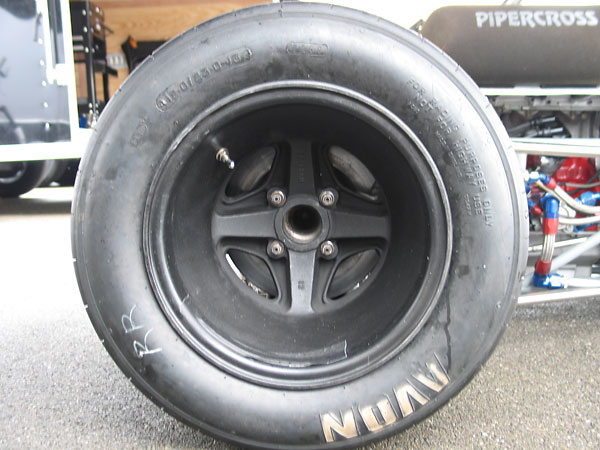
Avon racing tires (9.0/21.0/13 front and 12.0/23.0/13 rear).
All photos shown here are from September 2009 when we viewed the car at The US Vintage Grand
Prix at Watkins Glen.
All photos by Curtis Jacobson and Don Moyer for BritishRaceCar.com, copyright 2012.
All rights reserved.
| If you liked this article, you'll probably also enjoy these: | |||||
 |
Al Murray '67 Brabham BT21 |
 |
Bill Bovenizer '69 Titan Mk3 |
 |
Kyle Kaulback '71 Lotus 69 |
| You're invited to discuss anything you've seen here on The British Racecar Motorsports Forum! | |||||
Notice: all the articles and almost all the photos on BritishRacecar.com are by Curtis Jacobson.
(Photos that aren't by Curtis are explicitly credited.) Reproduction without prior written permission is prohibited.
Contact us to purchase images or reproduction permission. Higher resolution images are optionally available.



